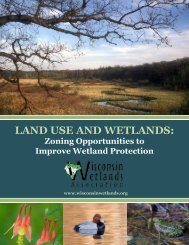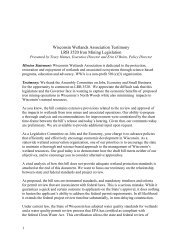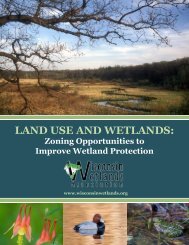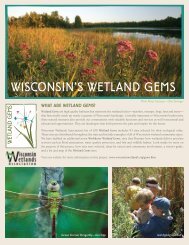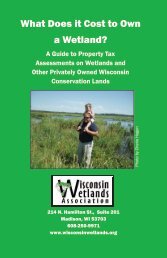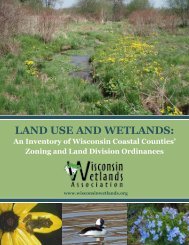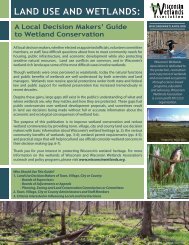The BergsTrom WeTland - Wisconsin Wetlands Association
The BergsTrom WeTland - Wisconsin Wetlands Association
The BergsTrom WeTland - Wisconsin Wetlands Association
Create successful ePaper yourself
Turn your PDF publications into a flip-book with our unique Google optimized e-Paper software.
<strong>The</strong> Bergstrom WetlandA Case Study on the Need forWetland Education and OversightOn February 3rd, 2011, Governor Walker signed 2011 Act 6 into law, clearing the way for development of a high qualitywetland at the intersection of Highway 41 and Lombardi Avenue in the Village of Ashwaubenon in Brown County. <strong>The</strong> billexempts the parcel from state wetland permit requirements and authorizes up to 3 acres of wetland fill. It also renderedmoot an August 2010 request by the <strong>Wisconsin</strong> <strong>Wetlands</strong> <strong>Association</strong> for an administrative review (i.e., a contested casehearing) of a wetland development permit issued for the project in July 2010.<strong>The</strong> legislation was controversial and widely covered in the media, with many interested parties expressing strong views insupport and opposition to the Bergstrom bill. And, as often occurs with wetland controversies, the facts about the wetlandwere largely misrepresented or misunderstood by project proponents.As a leading opponent of the Bergstrom bill and a party to the wetland permit dispute that preceded its enactment,the <strong>Wisconsin</strong> <strong>Wetlands</strong> <strong>Association</strong> developed this case study to set the record straight on many aspects of this case,including: our reasons and rights to request administrative review of the wetland development permits; the quality andvalue of the wetland parcel; how misinformation and misunderstanding fuels wetland controversies and erodes support forwetland protection; and how this bill sets several new and disturbing precedents.Twelve Spotted SkimmerWild IrisSpotted SandpiperBergstrom Wetland
History of the Bergstrom WetlandPermit Dispute / Special Exemption BillA prominent <strong>Wisconsin</strong> businessman, automotive dealer John Bergstrom, was behind the effort to develop the wetland parcel andlobby for the special exemption legislation. <strong>The</strong> parcel is located in a proposed 300-acre Tax Increment Financing District (aka TIFDistrict / Titletown Entertainment District) that is slated for redevelopment to bring new restaurants, entertainment venues, andretail establishments to the area surrounding Lambeau Field. As of February 3rd, 2011, Mr. Bergstrom did not own the property,but did hold an option to purchase it. A chronology of the permit dispute and special legislation follows.Doyle Administration Ignores Science and ReinterpretsLaws to Approve Fill of the Bergstrom Wetland (April - July 2010)April 30, 2010:Bergstrom submitted an application to the <strong>Wisconsin</strong>Department of Natural Resources (DNR) for a permit tofill wetlands on the site. <strong>The</strong> intended tenant was describedas an “outdoor and recreational sports retailer,” but a DNRAdministrator told the Green Bay Press Gazette on January 14,2011, “the working assumption” was that the permit was for aBass Pro Shop.May - June, 2010:DNR’s regional experts, (i.e., professional staff with educationand experience in wetland identification and site evaluation,wildlife habitat assessment, etc.) visited the site and reviewedthe application. In a written site visit report dated May 19,2010, the regional wildlife biologist stated: “This is one of thebest urban wetlands in my tenure and deserves to remainfunctional and intact.”July 2, 2010:<strong>The</strong> regional water management specialist, who has manyyears of experience reviewing wetland permit applications,documented these additional concerns by e-mail: “At thistime based on my review… I question whether theproposed project meets the required standards in NR 103.Granting WQC [a wetland fill permit] for this project mayset a precedent for future Department review of similardevelopment associated with potential wetlands impact.Based on awareness of this decision, it may becomeincreasingly difficult to maintain the integrity of thewetland program.”July 14, 2010:A cabinet-level DNR official signed and issued a wetland fillpermit authorizing 1.65 acres of wetland fill in exchange forwetland enhancements on site and the promise to “createor restore 4 acres of wetland on a separate property inthe vicinity.” <strong>The</strong>re was nothing in the permit file, from anyprofessional or program staff, that countered the conclusionsthat the field staff had made. <strong>The</strong> permit contained nodetails on the location or plans for the restoration project.<strong>Wisconsin</strong> <strong>Wetlands</strong> <strong>Association</strong> and our attorney, who had33 years of experience representing DNR in wetland cases,concluded that there was no factual or legal basis for theissuance of the permit.Citizens’ Rights to be HeardChapter 227.42 of state law grants concerned citizensand regulated businesses the opportunity to seek reviewof agency decisions. <strong>The</strong>se contested case hearingsoccur before an independent Administrative Law Judgewho compiles and reviews a complete project record.All testimony occurs under oath and is subject to crossexamination. <strong>The</strong> opportunity to challenge an agencyaction provides an important safeguard to ensure thatstate laws and rules are properly implemented andenforced. Petitioners must demonstrate that they have asubstantial interest in the matter (i.e., standing) and thattheir interest is protected by legislative intent.August 31, 2010:<strong>Wisconsin</strong> <strong>Wetlands</strong> <strong>Association</strong> and two Brown Countyresidents petitioned the Department for a contested casehearing (i.e., a legal review of the permit decision). Currentstate law forbids approval of wetland development permits ifpracticable alternatives to the project are available to avoid andminimize wetland fill, and if the fill would result in significantadverse impacts to wetland acres or functions. We requestedthe hearing because of evidence that the project was approvedby politically-appointed Madison administrators against therecommendations of qualified DNR experts in the region; thatpracticable alternatives within the proposed TIF District wereavailable; and that the project, as approved, would result insignificant adverse impacts to a high quality urban wetland area.<strong>Wisconsin</strong> <strong>Wetlands</strong> <strong>Association</strong>’s standing in this matter wasestablished through more than 40 years of involvement in thedevelopment and oversight of <strong>Wisconsin</strong>’s wetland protectionlaws. <strong>The</strong> two Brown County co-petitioners had standing aslocal residents and because of their status as professors ofwetland science at the University of <strong>Wisconsin</strong> Green Bay.In the last 10 years, <strong>Wisconsin</strong> <strong>Wetlands</strong> <strong>Association</strong>has reviewed and commented on hundreds of wetlandfill permit requests. This is only the second contestedcase hearing we have requested seeking judicialreview of a permit decision.2
Doyle Administration Grants Hearing Request then Buries the File (Fall 2010)September 2, 2010:DNR attorneys informed <strong>Wisconsin</strong> <strong>Wetlands</strong> <strong>Association</strong> thatthe request for a contested case hearing had been granted.DNR has the authority to deny the request if the petition is notrooted in facts and law.September - December 2010<strong>Wisconsin</strong> <strong>Wetlands</strong> <strong>Association</strong> made numerous phonecalls and sent several letters to DNR seeking information onthe status of the case, requesting that the file be sent to theDivision of Hearings and Appeals, and expressing a willingnessto participate in discussions to resolve the matter out of court.We also requested information about the proposed TitletownEntertainment District to help all parties evaluate project alternatives. Though used by the DNR to inform their permit decision,these documents were deemed proprietary by the applicant and were withheld.Throughout the process, we maintained that we believed there was a way to allow the development to proceed within theproposed TIF District, but without causing unnecessary harm to wetlands. Over the course of the next 5 months, Bergstrom’sattorney made clear that his client was unwilling to discuss any alternatives beyond filling the wetlands and mitigating elsewhere.Under normal protocols, if the parties to a contested case hearing cannot reach a negotiated resolution, the matter proceedsto hearing. In this case, Doyle-appointed Secretary Matt Frank chose to bury the file and leave the matter to be resolved by thenext administration. With no possibility of a hearing in sight, Bergstrom had little incentive to engage in a good-faith negotiation.Governor Walker Says No to Citizens’ Rights, No to <strong>Wetlands</strong>, and Yes to Bergstrom (January-February 2011)January 3, 2011:On his first day in office, Governor Walker issued an ExecutiveOrder calling a special legislative session on jobs and declaringan intent to exempt isolated wetlands less than 2 acres fromstate wetland permit requirements. Concerned about potentialroll-backs to the important isolated wetland protectionlaw passed in 2001 (2001 WI Act 6), <strong>Wisconsin</strong> <strong>Wetlands</strong><strong>Association</strong> led a statewide response in opposition to the bill.January 19, 2011:<strong>The</strong> <strong>Wisconsin</strong> Legislature responded quickly to Walker’sExecutive Order and Bergstrom’s lobbying with the release ofspecial session bill SB 10. <strong>The</strong> draft bill exempted all BrownCounty wetlands less than 3 acres in size from wetland permitrequirements if the area was zoned for business and part of aTIF District.January 28, 2011:In statements to the Green Bay Press Gazette, a BassPro Shops spokesman said his company had held onlyexploratory conversations with a developer who wantedto bring in a Bass Pro Shops to anchor the project nearLambeau Field. <strong>The</strong> spokesman said: “We were unawareof any wetland issue and have not and will not be infavor of doing anything to harm wetlands, whereverthey might be.” Despite this turn of events, the legislatureand Governor Walker continued to fast-track the bill.January 28 - February 2, 2011:Despite Bass Pro Shops’ announcement (see box), an amendedbill passed in both the Assembly and Senate Natural ResourcesCommittees. <strong>The</strong> bill was further narrowed to apply only toisolated wetlands in the Village of Ashwaubenon, providedthe wetland area to be impacted was less than 3 acres insize, zoned for business, and located in a TIF District. <strong>The</strong>seamendments confirmed that the bill was private legislationdrafted to benefit John Bergstrom.February 2, 2011 - World <strong>Wetlands</strong> Day:On World <strong>Wetlands</strong> Day, and in the middle of a blizzard, thethe Bergstrom wetland exemption bill was passed by bothhouses of the <strong>Wisconsin</strong> Legislature. All Republicans present,and two Democrats, voted in favor. <strong>The</strong> remaining Democratsopposed.February 4, 2011:Governor Walker signed the Bergstrom wetland exemptionbill into law. In a press statement about the bill, Walker stated“This is our Ashley Furniture moment, to show that weare serious about reforming DNR and other agencies tobalance regulatory needs with job creation.”Note: <strong>The</strong> provision in <strong>Wisconsin</strong>’s 1999 State Budget toexempt an Ashley Furniture expansion from state wetlandlaws was overturned in Trempeleau County District Court. Aproject with reduced wetland impacts was approved in 2005after going through a proper permit review process.3
Historical and Current Values of the Bergstrom Wetland:Fiction versus FactsWas THIS Wetland Worth All the Fuss?<strong>Wisconsin</strong> <strong>Wetlands</strong> <strong>Association</strong>’s request for a hearing was as much aboutresponding to a precedent-setting departure from standard, science-basedwetland permit review protocols as it was about concerns over destructionof a high-quality wetland.Approximate locationof Bergstrom WetlandWith the matter before the legislature, it became less about the wetland andmore about good governance and upholding the public’s long-standing rightsto question their government.But yes, in fact, this wetland is worth fighting for. In keeping with ourtradition as a science-based organization, we present the followinginformation about the quality and functions of the Bergstrom wetland.Is the Bergstrom Parcel Even a Wetland?Several <strong>Wisconsin</strong> legislators and some bloggers described the wetland asman-made and questioned whether there was even a wetland on the site.Some believed the wetland formed when US Highway 41 was built.In fact, there is no question that the area to be filled has been a wetlandsince before <strong>Wisconsin</strong> was even a state. Field notes from an 1843Historical Survey describe the area as an Eastern cedar and black ashSwamp.Dr. Bud Harris, Dr. Robert Howe, and Gary Fewless, all wetland expertsfrom the University of <strong>Wisconsin</strong>-Green Bay (UWGB) said this about thesite: “From aerial images as early as 1938 and ending in 2004 and fromthe Green Bay West topographic map, we can be reasonably confidentthat the Lombardi Avenue wetland was part of the Beaver Dam CreekWatershed that drains to Duck Creek and eventually into lower GreenBay. <strong>The</strong> hydrology of the area and the extensive forested wetlands(some of which persist yet today) have been markedly modified.Before modification, this wetland was part of an extensive complexof headwater wetlands draining to ecologically significant coastalwetlands of Green Bay.”Today, the Bergstrom wetland is classified as an “isolated wetland” becauseit has been cut off from downstream waters by adjacent development. <strong>The</strong>parcel contains ~11 acres of “developable land.” <strong>The</strong> soil survey submittedwith the permit application confirmed that this 11-acre area is actuallywetland fill. A review of aerial photos revealed that the fill was placedsometime between 1998 and 2002. This filled portion of the parcel isunsightly. All that is visible is sand and gravel and trash.<strong>The</strong> wetlands that remain to the north and south of this fill, however, havemaintained a remarkable amount of diversity, structure, and function. Forexample, the site ranks high to exceptional quality for floristic diversity.<strong>The</strong> wetland contains sedge meadow communities and provides habitat fornesting woodcock, sandhill cranes and other migratory birds.“Wetland complexes with this degree of values and services are rare inurban settings.” ~ UWGB wetland experts.Prior to construction of US Highway 41, the1938 aerial photo shows that the Bergstromwetland was part of an extensive complex ofheadwater wetlands and fully connected withthe surrounding landscape.Yellow outline =parcel that includesan ~ 20 acrewetlandBy 1992, the aerial photo shows that theBergstrom wetland has been disconnected (orisolated) from adjacent wetlands by US Highway41 and surrounding development. Despite thisencroachment an ~ 20 acre wetland is still intact.Large white areanear north-centralpart of parcel =location of ~ 11acres of wetland fillBy 2010, a portion of the Bergstrom wetlandhas been significantly altered due to fill placedsometime between 1998 and 2002. <strong>The</strong>remaining wetlands maintain a remarkableamount of diversity, structure, and function.4
Is the Bergstrom Wetland Overrun by Invasive Species?Project proponents (Bergstrom’s attorney, some legislators, and cabinet-level DNR administrators) said the site was mostly orsoon to be completely over-run by invasive species and that what was being proposed was in the best interest of the wetlands.Tufted LoosestrifeTrained scientists offered a different perspective. For example:<strong>The</strong> DNR Wildlife Biologist stated: “Primarily Phragmites was present only onthe disturbed portions near the highway fence and already filled in portionsof what probably was a larger wetland complex. In the proposed wetland tofill, few invasives were present.”Woodcock NestWetland experts from UWGB concluded: “Additional alteration of thehydrology that results in drier conditions will also further degrade theremaining wetlands by increasing erosion and creating conditions that arefavorable for the spread of Phragmites australis and other invasive species…increasing human alteration of these wetlands will only exacerbate thealready precarious ecological integrity and biodiversity at this site.”<strong>The</strong> UWGB wetland experts also noted: “Any increase in disturbance byhuman activities will reduce the nesting value for Woodcock and SandhillCrane, and will degrade breeding, stopover, foraging, and protective coverhabitat for amphibians, deer, small mammals, and other resident andmigratory wetland vertebrate species.” ~ Memo from Dr. Bud Harris, Dr.Robert Howe, and Gary Fewless to <strong>Wisconsin</strong> <strong>Wetlands</strong> <strong>Association</strong>.If a Developer Creates More Acres of <strong>Wetlands</strong> than are Destroyed,Why isn’t Wetland Enhancement and Mitigation Always a Reasonable Solution?<strong>Wetlands</strong> are complex and valuable components of <strong>Wisconsin</strong>’s landscape. In recognitionof the public benefits wetlands provide, state and federal laws discourage development inwetlands by requiring that projects be designed to first avoid, and then minimize, wetlandimpacts.While wetland mitigation is an important tool to help compensate for unavoidablewetland impacts, scientists agree that acreage alone is not a reliable indicator of whetherthe area restored is better than, or even comparable to, what’s been destroyed.<strong>The</strong>re was no evidence inDNR’s files that any qualifiedstaff (i.e., those with trainingand expertise in wetlandecology and site evaluation)agreed that the proposedenhancements adequatelyoffset the proposed fill.This is because wetlands develop over the course of thousands of years based on theecological processes of the surrounding land and water. Wetland functions are site-specific and can be difficult to replicate,particularly when the wetland to be filled is high quality, such as the Bergstrom wetland. Some wetland types (e.g., floodplainforests) can’t be replicated at all, and many mitigation projects fail to restore wetland hydrology or vegetation.Even when a wetland of comparable size, type, and quality is successfully created elsewhere on the landscape, the locallyimportant functions such as flood storage, water quality improvement, and wildlife habitat are lost from the filled site forever.This can be particularly problematic in urban areas, where few wetlands remain to provide these critical services.<strong>The</strong>se shortcomings do not mean that mitigation should never be allowed, but the promise of mitigation should not be used tojustify the unnecessary destruction of high quality wetlands. In the case of the Bergstrom wetland, alternative locations for theproject within the proposed 300-acre redevelopment (TIF) district were not adequately evaluated.Under state law, permits for wetland fill can not be granted if the project will result in a significant adverse environmental impact.<strong>The</strong> decision-makers, DNR administrators, were not qualified to evaluate the unique functions and services of the Bergstromwetland or whether they could be replaced. In fact, they did not even have the information needed to make an informed decision.A condition in the permit required that 4 acres of wetlands be “created or restored” in the vicinity. Not only was there noapproved plan describing the location, type, or functions of the wetlands to be established, there was no evidence in DNR’s filesthat staff with training and expertise in wetland ecology and site evaluation agreed that the proposed restoration adequatelyoffset the permitted fill.5
<strong>The</strong> Need for Wetland Education and OversightDuring the course of the political debate about the merits of the Bergstrom bill, a great deal of misinformation was shared aboutthese wetlands by individuals with no training in the identification of wetland boundaries and wetland plants or the evaluationof wetland functions and quality. In contrast, expert testimony and analyses submitted during private meetings with legislatorsand as part of public testimony were routinely ignored. Moreover, the public debate as played out on message boards and blogsshowed that wetlands are still a greatly maligned and misunderstood resource.Whether deliberately false or genuinely misinformed, the allegations that theBergstrom wetland was highly degraded and of little value interfered with<strong>Wisconsin</strong> <strong>Wetlands</strong> <strong>Association</strong>’s ability to engage decision-makers in an honestand good faith dialogue about the value of these wetlands and the merits of ourchallenge to DNR’s permit decision. <strong>The</strong> misinformation also made decisionmakersunwilling to discuss whether the proposed project (for which there was noconfirmed tenant) would be better sited in an alternative, near-site location.Precedent Setting Implications of 2011 <strong>Wisconsin</strong> Act 61. 2011 <strong>Wisconsin</strong> Act 6 placed new limits on the public’s right to question government decisions. For decades, statelaw has provided opportunities for individuals, organizations, and businesses to seek an objective administrative review ofstate agency decisions. <strong>The</strong> laws have always applied equally to businesses, organizations, and individuals and offer the sameopportunities to interests that believe an action should have been taken as to those who believe an action taken should nothave been. <strong>The</strong> Bergstrom bill put the interests of an influential business owner above the rights of the concerned membersof the public. A private law was written to circumvent <strong>Wisconsin</strong> <strong>Wetlands</strong> <strong>Association</strong>’s right to a hearing. This sends amessage that citizen involvement in government decision making is not welcome.2. 2011 <strong>Wisconsin</strong> Act 6 put the <strong>Wisconsin</strong> Legislature and the Governor’s office in thebusiness of adjudicating a case. <strong>Wisconsin</strong> <strong>Wetlands</strong> <strong>Association</strong>’s challenge of DNR’spermit decision was tried and decided in the Capitol, without the benefit of testimony andcross examination under oath, or a full review of the facts of the case as they were appliedunder current state laws. Our right to due process was violated. Science and laws wereignored.3. 2011 <strong>Wisconsin</strong> Act 6 set a new precedent for how wetland development decisionswill be made. <strong>The</strong> heart of <strong>Wisconsin</strong> <strong>Wetlands</strong> <strong>Association</strong>’s challenge was that DNR’sdecision did not conform to state water quality standards for wetlands. DNR ignored thebest available science and allowed the promise of mitigation to come before the applicant’sobligation to avoid and minimize wetland impacts. We challenged the decision because,if let stand, it would set a new standard for the review and approval of wetland permitdecisions. Without the benefit of a review of the facts of the case and sworn experttestimony, the legislature decided this new standard should be granted the force of law.As the new norm, the public has little assurance that naturally occurring high quality wetlands will continue to be protected.4. 2011 <strong>Wisconsin</strong> Act 6 granted permission to fill wetlands, despite the absence of a project. DNR approved a permitfor 1.65 acres of wetland fill based, supposedly, on the design standards and business needs of Bass Pro Shops. Bass ProShops later indicated it had made no commitments and was unwilling to build on this site. <strong>The</strong> legislature rewardedBergstrom for misrepresenting the business interests and needs of Bass Pro Shops with a bill that granted permission tofill even more wetlands (up to 3 acres). Before now, permission to fill wetlands was granted only when there were nopracticable alternatives to meet the basic purpose of a specific development project. Without the benefit of a rationallocal planning process, this bill erroneously assumes the Bergstrom wetland must be filled in order for the TitletownEntertainment District redevelopment project to succeed.222 S. Hamilton St, Suite 1Madison, WI 53703608.250.9971www.wisconsinwetlands.org<strong>The</strong> Ironies of 2011 Act 6.2001<strong>Wisconsin</strong> Act 6 establishedstatewide protections for all of<strong>Wisconsin</strong>’s isolated wetlands.Ten years later, 2011 <strong>Wisconsin</strong>Act 6 created a special exemptionfrom wetland laws for an isolatedwetland parcel in the Village ofAshwaubenon, Brown County.<strong>The</strong> bill was passed by theLegislature on World <strong>Wetlands</strong>Day (February 2nd) and signed bythe Governor the day after.<strong>Wisconsin</strong> <strong>Wetlands</strong> <strong>Association</strong> is dedicated to the protection, restoration and enjoymentof wetlands and associated ecosystems through science-based programs, education andadvocacy. We thank all those who tracked this issue alongside us and made your supportfor wetland protection known through letters to elected officials and your local media.Note: All photos in this document are of the Bergstrom Wetland and were acquiredthrough an open records request from the <strong>Wisconsin</strong> DNR.



